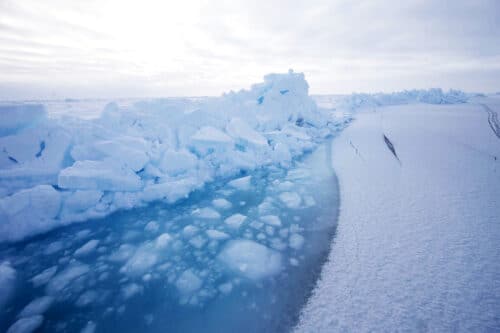Why is the Ocean “blue”?

The ocean is a massive body of saltwater, connected throughout the globe, that covers roughly 71% of the total surface of the planet.
Usually, due to historical, cultural, and geographical factors, we divide it into 5 major basins: the Pacific, Atlantic, Indian, Arctic and Southern Oceans.
The ocean contains more than 97% of Earth’s water, and it supports 99% of the total biosphere. As you can guess from this information, the ocean is extremely important for life on our planet, and it works as its support system, mitigating climate change, producing oxygen, and providing humans with food and economic opportunities.
Due to its vastness, only 5% of the ocean has been explored and charted by humans. The rest, especially its deepest parts, remain unexplored.
There is one thing we all know for sure, however, and it is that the ocean and the sea appear to be blue. Why is it so?
In this article, we will explain why the ocean is blue, so that you can finally understand how it works.
Is the Ocean blue?
Of course, we all know that clean water is colourless, it is transparent. So then, why does the ocean appear blue? And so do other bodies of water.
For many years, people believed (some still do!) that the ocean and other water bodies are a shade of blue because they reflect the blue sky. This is not true!
Sure, water does reflect the sky on its surface: from the coast, it may appear blue on a sunny day, grey when it’s stormy, or even show shades of pink during sunset. But if we sink below the surface, however, the blue colour remains, and it does when we look at the ocean from space, too. In these cases, the water isn’t reflecting the sky.
The reason behind the ocean appearing blue does, in fact, involve reflection, but it is not simply a mirror of the sky.
As we know, sunlight contains the full spectrum of colours, as we see in rainbows, it contains all hues, from red to violet. Different colours of light possess different wavelengths, with red light having longer wavelengths. The wavelength of other colours become progressively shorter, with blue and violet at the end of the range, with the shortest of all.
When light hits the ocean, the water absorbs colours with longer wavelengths first, reflecting to our eyes those with shorter wavelengths. Like a filter, water molecules absorb the red parts of the light spectrum and leave behind colours on the blue spectrum, which are reflected to our eyes.
As soon as we reach a depth of a few meters, then, most red and orange light has vanished entirely, absorbed by water molecules. Then, yellow, and green wavelengths are also absorbed, leaving blue and violet, which have the shortest wavelengths of visible light, and are therefore able to penetrate deeper.
This, however, only happens ups to a certain depth: actually, most of the ocean is completely dark as hardly any light penetrates deeper than 656 feet, and no light at all reaches deeper than 3,280 feet.
Do all water bodies appear blue?
Everything absorbs light at a different wavelength, and then reflects the remaining colours back at a viewer.
When light penetrates water completely, like in a drinking glass or a very shallow body of water, we see water as colourless, as not enough photons are absorbed. Light just shines through.
This is mainly why different bodies of water can have different shades of blue. The deeper the basin, the darker and deeper the colour will be, as the more water there is, the lighter gets absorbed.
You may have noticed that, sometimes, water can also appear to be colours other than blue.
This is often the result of characteristics of the water or the floor.
Some rivers or ponds, for example, may appear to be a muddy brown rather than blue, which is often due to the presence of sediments in the water, especially after the water has been stirred.

The crystal-clear waters of the Caribbean, which are usually closer to shades of light green rather than blue, you may have thought that it is because the water is cleaner. Of course, that does have an impact, but often the colours are given by the plant life that exists in many Caribbean waters, which can contribute to more green light being reflected.
Often, the most beautiful Caribbean waters also tend to be shallower, and the composition of the ocean floor, mainly corals, can be responsible for a different way of reflecting light.
Why are scientists studying the colour of the ocean?
Some types of particles (for example the cells of phytoplankton, also referred to as algae) also contain substances that absorb different wavelengths of light, altering the colour reflected by the water. There are many substances in water that absorb light and thus modify the colours reflected. Usually, these substances are composed of organic carbon and scientists generally refer to them as CDOM, short for coloured dissolved organic matter.
One essential light-absorbing substance in the ocean waters is chlorophyll, which phytoplankton use during the process of photosynthesis. Chlorophyll is a green pigment, and therefore phytoplankton preferentially absorb the red and blue portions of the light spectrum for photosynthesis, therefore reflecting green light.
Thus, regions of the ocean with high concentrations of phytoplankton appear with different shades from the usual blue: they go from blue-green to green, depending on the density and type of the phytoplankton population they contain.
The principle that lies behind the studying of ocean’s colour from space is simple: the more phytoplankton in the water, the greener it will appear; the less phytoplankton, the bluer it will look.
Thus, scientists are studying the ocean colour to gain a better understanding of phytoplankton and how it influences the Ocean and Earth.
It has been found that these small organisms can have great impact on a system on a large scale, such as climate change. For example, phytoplankton use carbon dioxide for photosynthesis, providing almost half of the oxygen we breathe on the planet. Therefore, a large and thriving world’s phytoplankton population means that more carbon dioxide gets pulled from the atmosphere, mitigating the effects of pollution, and lowering the effects of global warming and climate change.
Scientists have discovered that a given population of phytoplankton can double its numbers about once per day, which means it is able to respond very rapidly to changes in their environment.
Examining the colour of the oceans helps researchers to understand and monitor phytoplankton, which can be a step towards predicting environmental change.
Changes in each phytoplankton population, such as variations of its density, distribution, and rate of population growth or diminishment, will alert scientists of changing environmental conditions.
References
https://oceanservice.noaa.gov/facts/oceanblue.html
https://www.scientificamerican.com/article/why-does-the-ocean-appear/
https://www.whoi.edu/know-your-ocean/did-you-know/why-is-the-ocean-blue/
https://science.nasa.gov/earth-science/oceanography/living-ocean/ocean-color


